Dart frogs are tough critters and the ultimate survivor. They don’t need high-care, rather a moderate look after would be okay to pet them for years. Which is why they make a great pet to have.
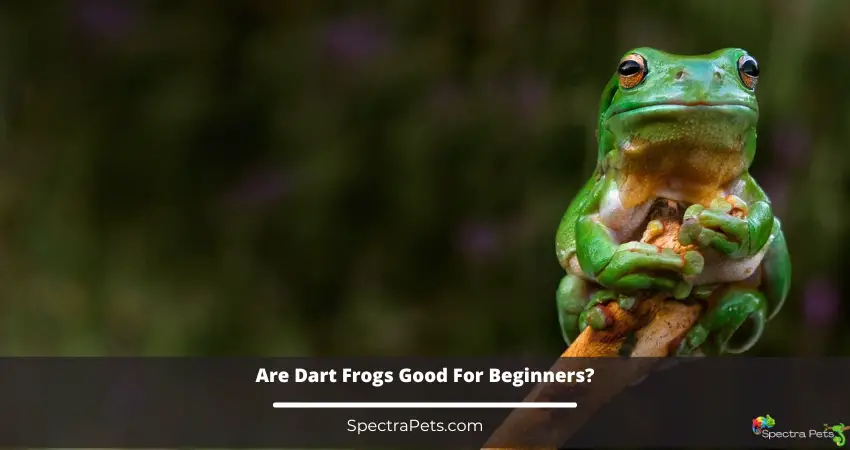
In fact, for a beginner, Bumblebee Dart Frog, Poison Arrow Dart Frog, Black Legged Poison Dart Frog, Green & Black Dart Frog, and Blue Poison Dart Frog are some of the best frogs to have.
Ensuring the basic things like proper tank size, the right amount of food, perfect climate, frog-friendly substrate, and monthly cleaning would make their place a lovely habitat for these magnificent frogs. And all of these are amazingly low effort work.
Don’t believe me? Why don’t you hop down below and see for yourself?
Which dart frogs are best for beginners?
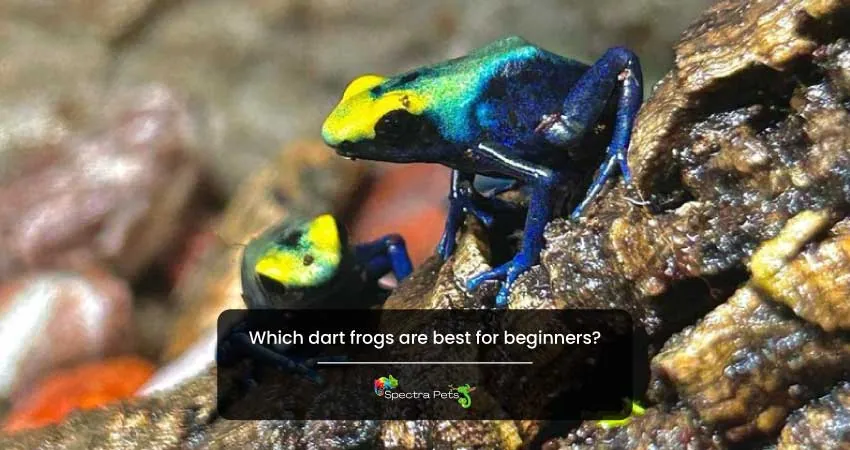
Image Credit: Instagram, dart_frogs_friends
Though there is a huge variation of poison dart frogs, some are so pet friendly that you want to get them as soon as you see their activity.
I am adding a table where you will see the highest-selling dart frogs in the current market..
| Common Name | Scientific Name |
| Bumblebee Dart Frog | Dendrobates leucomelas |
| Poison Arrow Dart Frog | Dendrobates tinctorius |
| Green and Black Dart Frog | Dendrobates auratus |
| Black Legged poison dart frog | Phyllobates bicolor |
| Blue Poison Dart Frog | Dendrobates tinctorius |
| Golfodulcean Poison Arrow Dart Frog | Phyllobates vittatus |
| Yellow Striped Poison Dart Frog | Dendrobates turncates |
You can get all these dart frogs with a cost range of $25-$150.
Can a beginner build a dart frog habitat easily?
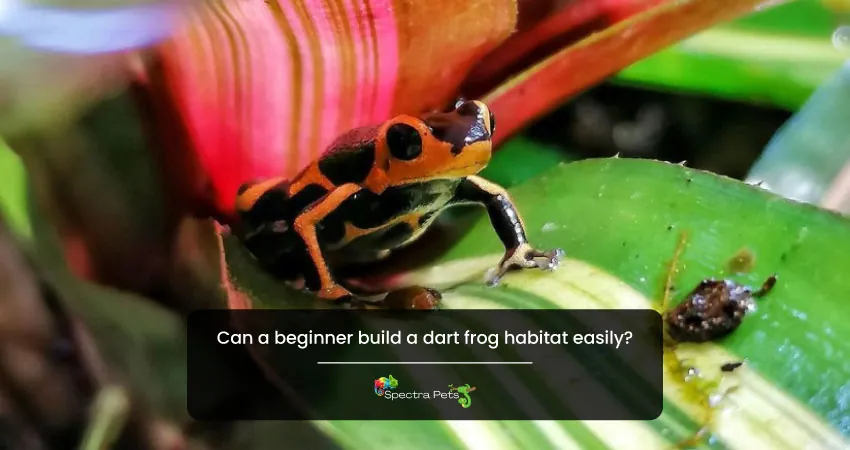
Image Credit: Instagram, terribilis_germany
While making an ideal environment for dart frogs sound very hard to do, in reality, it’s a simple process. Simply collect the required stuff and arrange them side by side. If you never did a tank setup then it might take you 3-4 hours to complete the setup of the poison dart frog habitat.
I’ll walk you around the necessary process:
What You’ll Need
To ensure the perfect climate for your poison dart frog you will need some kits and stuff. These are the following…
- A terrarium of the right size
- Thermometer and hygrometer
- Lighting
- Substrate
- Decoration
- Glass lid
- Misting system
Let’s have a brief look at these necessary supplies.
First, you’ll need a terrarium of the appropriate size. These frogs don’t get very big, so a 10-gallon tank should be plenty of space if you plan to keep 1 dart frog.
You’ll also need substrate, which you can find at your local pet store. Coconut husk is a good option, as it holds moisture well and breaks down slowly over time, providing nutrients for the plants in your terrarium.
You’ll need a misting system to keep the humidity high enough for your frog. These frogs like their habitat to be between 70 and 80 percent humidity. To make sure your terrarium stays at the correct level, use a thermometer and hygrometer to monitor the temperature and humidity levels.
Moreover, these amphibian buddies also need lighting. A full spectrum UVB light is necessary for your frog to synthesize vitamin D3, which is essential for calcium absorption. This will help prevent health problems like a metabolic bone disease.
In addition to UVB light, you’ll also need an infrared heat bulb to create a basking spot for your frog. This spot should be around 88 degrees Fahrenheit during the day and can be turned off at night. Once you have all the necessary supplies, it’s time to set up your terrarium.

Setting Up Your Terrarium
The first step is to add the substrate to your tank. You’ll want about two inches of substrate for your frog to burrow in and feel secure. Once the substrate is in place, you can add decorations like rocks, tree branches, and plants. Be sure to use only live plants that have not been treated with chemicals.
After you’ve added all the decorations, it’s time to install the misting system and heating elements. Place the heat bulb on one side of the tank and the UVB light on the other so that your frog has a temperature gradient to choose from throughout the day.
After that, set up the misting system according to the manufacturer’s instructions and turn it on so that it runs for two minutes every hour or so.
Finally, place the glass lid on top of your terrarium and let it sit for 24 hours before adding your frog. This will give ample time for any chemicals in the new materials to off-gas before your frog is exposed to them.
So, you can see that housing the poison dart frog is a bit time taking but it’s not complicated for a beginner like you.
What animals can you keep with your dart frog in the large terrarium?
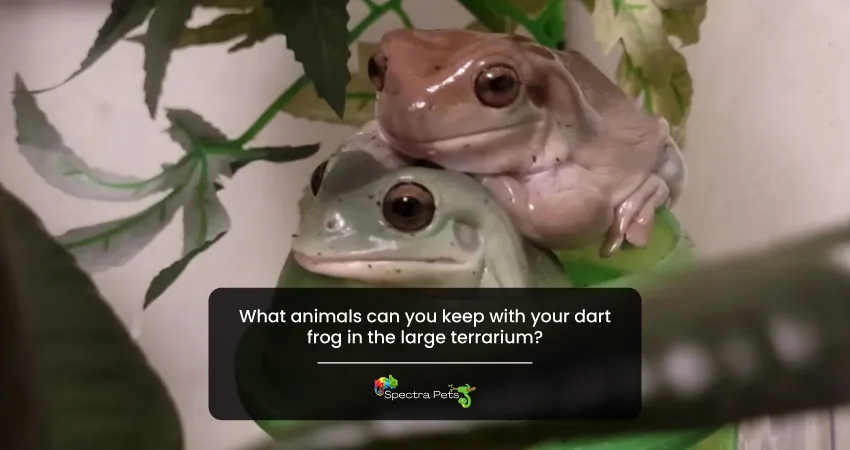
Image Credit: Instagram, dumpy_tree_frog
Though the glossy frogs don’t really need others to stay around them, they do have the habit of living in groups. As a beginner you can add lemur tree frogs, mourning geckos and fire bellied toads, etc. Luckily these animals are highly beginner-friendly because they require less maintenance. So you won’t feel the extra burden of keeping them in the tank.
In the wild, they live in a harmonious relationship with different types of species so do in captivity. Let’s see some of those animals in the following…
Lemur Tree Frogs
Lemur tree frogs are small frogs that come in a variety of colors, including red, yellow, green, and blue. These frogs are native to Central and South America and do well in captivity. Lemur tree frogs can be kept with other lemur tree frogs or with dart frogs of the same species.
Can you keep dart frogs with tree frogs? – [Read Here]
Mourning Geckos
Mourning geckos are native to Madagascar and make good pets. Mourning geckos can be kept with other mourning geckos or with dart frogs of the same species. It is important to note that mourning geckos are nocturnal animals and may not be active during the day when you want to observe them.
Other dart frogs
If you have two poison dart frogs of different genders but the same species, then you can keep them together in the same tank without any problems.
However, if you have two males or two females of the same dart frog species, they will fight each other unless they have enough space to establish their territory within the tank I have a whole article named ” can you keep dart frogs together”.
Fire Bellied Toads
One of the best animal companions for dart frogs is fire-bellied toads. They are a similar size to poison dart frogs, so they won’t overwhelm your tank. They also have similar care needs and prefer a humidity level between 60 and 80%. Fire-bellied toads are also fairly active, so they will add some movement to your tank. Just make sure to get a male and female pair so they don’t outcompete your dart frogs for food.
Springtails
These tiny insects live in damp environments like forests or wetlands. They make good companions for dart frogs because they help keep the enclosure clean by eating mold and bacteria.
Why are dart frogs good for beginners?
Unlike other frog species, dart frogs require less maintenance and care. As a beginner for anyone, it would be hard to monitor the temperature and humidity continuously. But dart frogs’ amazing survival instincts help them to deal with a slight environment change for quite a long time.
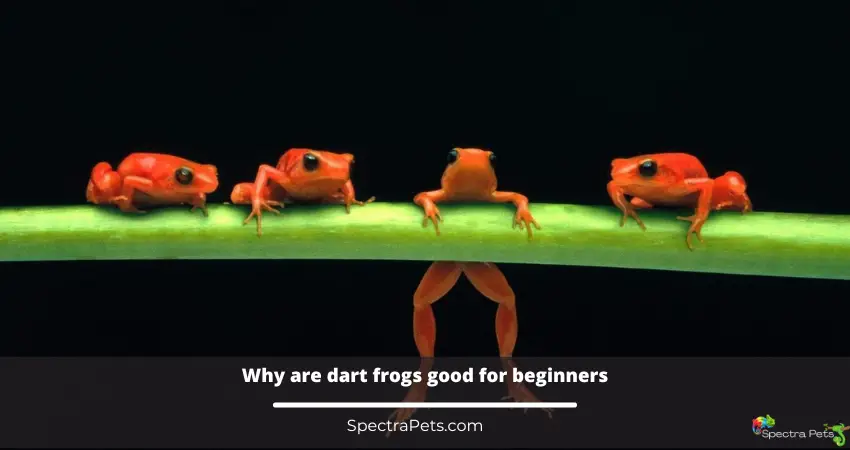
Along with that, they are not picky eaters, they love to roam around so you will watch them walking openly inside the tank. Moreover, they are not poisonous in captivity. All these things make it the perfect frog for beginners.
So in the following let’s have a look at these with more details…
Dart frogs are easy to feed
Dart frogs are carnivores, and their diet consists primarily of small insects such as ants, termites, and beetles. In the wild, poison dart frogs will also eat other small animals such as spiders, lizards, and mice.
In captivity, however, poison dart frogs can be easily fed a diet of commercially available insect foods. However, that’s not encouraged at all. Experts and hobbyists suggest culturing dart frog feeders like isopods, springtails, fruit flies, larvae of black soldier flies, and pinhead cricket. phoenix worms, calci worms, etc.
Being said that, it’s a big no to provide them with any dead insects and they won’t even eat dead prey. You have to give them live insects. You can get more information about what do dart frogs eat by reading my other article.
Low maintenance
The dart frogs require minimum maintenance which makes them an excellent pet for people who are going to first-time owners of frogs. Weekly maintenance is enough instead of daily maintenance. When the topic is maintenance, it includes cleaning the misting machine, proper trimming of the plants, water replacement, substrate cleaning, etc. If you do the plant trimming only one time per month, it will be good to go.
The best news for you is that you don’t have to clean the poop of a poison dart frog at all. Their poop will be naturally decomposed with the substrate layer. In captivity, mist of the reptiles and amphibians, and wastages have to be cleaned regularly which makes the dart frog quite unique.
Unlike other frog species like the Pacman frog, you don’t need to fret about your dart frog eating stuff like eating substrate. Without any live food, they won’t eat anything. So the chance of getting impacted like other frogs is literally zero.
Furthermore, this little buddy does not have any interest in eating up plants and other decorations. So you can stay relaxed having this insectivorous frog in the enclosure.
Easily controllable temperature
With unique physical attributes, these colorful frogs can easily survive in the tank if you keep them under room temperature. Fortunately, these frog species do not require any heating lamps to regulate their temperature.
If the room temperature remains within 70-84 degrees Fahrenheit and you see the poison dart frog being active plus eating food then it’s fine. Though the temperature might fall a bit at night time, that’s not a big deal for these frogs.
However, if you live in a state where it’s too cold even the room temperature does not feel right. Then a heating lamp would be required from the beginning.
Non-toxicity in captivity
It’s important to note that not all dart frogs are created equal. Captive-bred dart frogs are non-poisonous, while wild-caught frogs may be toxic. This is because captive-bred frogs are typically fed a diet of insects that do not contain the toxins that can be found in the wild.
As a result, captive-bred frogs are safe to handle and make ideal pets for both children and adults. When choosing a poison dart frog, be sure to ask your breeder about the animal’s diet to ensure that you are getting a safe and healthy pet.
However, the golden poison dart frog is the only dart frog that remains highly toxic even in captivity. Here is a link to my article where I describe poisonous dart frogs in greater detail.
Even though they won’t be harmful if you touch other dart frog species in the enclosure, it would be best if you didn’t. Due to their sensitive skin, you should avoid touching them most of the time. Only in emergency situation handle these creatures using good quality gloves.
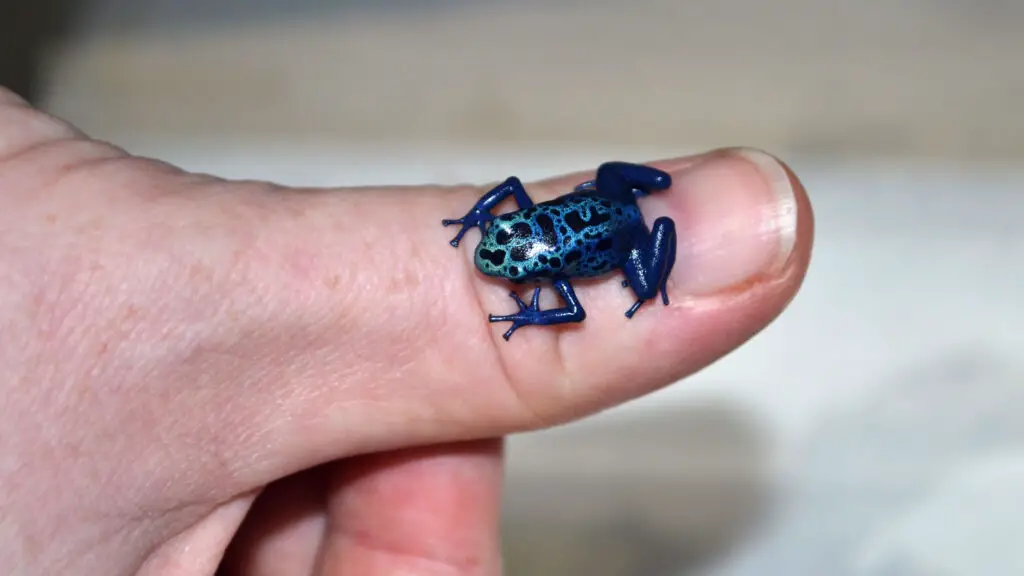
Breeding of dart frogs is easy
Dart frogs would be an excellent option for easy breeding. You as a beginner can get a good number of the baby frogs by breeding the adult poison dart frog.
All you need is to mimic a rainy season vibe inside the terrarium and the rest of the work they will do happily. Even if you don’t add that vibe, an adult pair can breed smoothly without any hassle.
Right after breeding, wait for a few days for the eggs, collect them, and take good care of the tadpoles. As soon as they become juvenile, you can sell them online or offline. Which will help you earn some extra dollars.
Have long life & less affected by sickness
In terms of lifespan, poison dart frogs get around 10-15 years in captivity. These marvelous frogs have excellent adaptability. I compared the lifespan of different dart frog species in another article [Read from here].
Compared to other frogs, it’s less sensitive and in one sense these are tough tiny creatures. They do get caught by sickness but that’s really low. Along with that, they have amazing resistance to facing stress.
Low-cost maintenance
Dart frogs are a popular pet for many people, but what does it cost to keep them healthy and happy? Surprisingly, the maintenance cost of a poison dart frog is relatively low.
If you are keeping them in a captive environment, you will need to provide them with food, water, and shelter. You will also need to maintain the temperature and humidity levels in their enclosure.
However, if you are keeping your dart frogs in a naturalistic setup, they will likely require less maintenance. With proper care, dart frogs can make an excellent addition to your family at a reasonable cost.
For food costs you don’t have to spend more than $20 per dart frog. While their humidity maintenance/ lighting cost/ heating lamp cost will be around $15-$20.
Astonishing skin color & pleasant sound
It would be hard for anyone to look at other things right after looking at a colorful dart frog. Their skin is designed so flawlessly with ultra bright colors, mind-boggling patterns, and unique stripes.
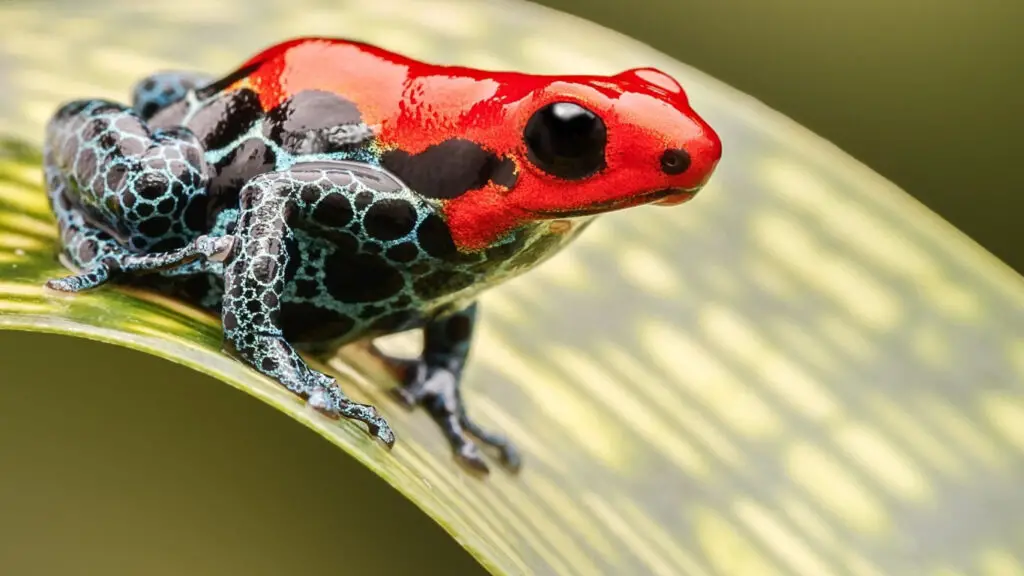
Though quiet in nature, the poison dart frog sometimes makes a beautiful sound that feels good in the ears. This is quite different from other frog species which makes a scratchy feel on the eardrums.
Highly active in day time
Due to their diurnal nature, the dart frogs do a lot of activity & movement in the daytime. Which provides great exposure to the owner. Along with that, they won’t disturb you by generating noise at night time like other frogs.
If you have kids in your home, they gonna love it. It just feels really good watching them moving and eating. Simply a stunning sight for you as an owner.
Group living is not problem for dart frogs
The easy & simple rule of keeping dart frogs in the group is to allocate 5-10 gallons for each frog. Anything less than that would be stressful for them.
Add lots of hiding places and keep the female number higher than the male one inside one enclosure. To have an in-depth idea take a tour of my article regarding keeping dart frogs together.
Wrapping up
Even though you are a newbie, hopefully, this article gave you a details idea about how easy it is for you as a beginner to pet this amazing creature.
The lower maintenance & physical toughness of this ultra adaptable frog make it one of the best frogs for beginners. Now you can begin the journey as a frog owner!
